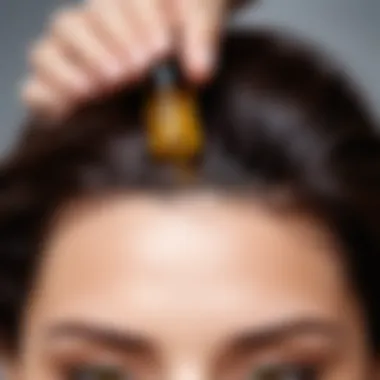Understanding Hair Oil: Mechanisms and Benefits


Intro
Hair oil has become a staple in personal care routines for both men and women, transcending cultural boundaries and becoming a subject of interest among diverse age groups. The benefits of hair oil extend far beyond mere shine. Understanding its mechanisms, key ingredients, and application techniques can significantly enhance the hair care experience. This article provides an in-depth exploration of hair oil, examining its functional properties and the science behind its effectiveness.
Furthermore, the role of formulation in hair oil is crucial. With various brands offering unique concoctions, selecting the right product becomes essential to achieving optimal results, particularly for enhancing scalp health and improving hair texture. Readers will discover how hair oils nourish and protect strands while exploring recommendations that cater to different hair types.
Популярные акции и предложения
As hair oil gains popularity, various cosmetics brands offer promotions and discounts. Keeping an eye on these can be beneficial for anyone looking to enhance their hair care routine without overspending.
Обзор текущих скидок на косметические бренды
Many well-known brands, such as Moroccanoil and SheaMoisture, periodically offer discounts on their hair oils. Shoppers can find promotional codes on their websites or through platforms like Reddit and Facebook. These discounts often range from 15% to 30%, making premium hair oils more accessible.
Сезонные распродажи и специальные предложения
Events like Black Friday and Cyber Monday also provide excellent opportunities to purchase hair oils. Brands may bundle products, offering more value for money. Being aware of these seasonal sales can help consumers maximize their investments in hair care products.
Choosing the Right Hair Oil
Selecting the appropriate hair oil involves understanding individual hair types and the specific benefits each oil provides. Different formulations address various needs, such as moisture, repair, or frizz control.
Key Ingredients in Hair Oils
Some of the prominent ingredients found in hair oils include:
- Argan Oil: Rich in fatty acids, excellent for hydration.
- Coconut Oil: Known for its penetrating properties that strengthen hair.
- Jojoba Oil: Mimics scalp's natural sebum, making it ideal for all hair types.
- Olive Oil: Effective for deep conditioning and managing split ends.
Application Techniques
Effective application of hair oil is critical for achieving the desired results. Here are some beneficial techniques:
- Pre-wash: Apply oil to dry hair 30 minutes before washing to protect against damage.
- Post-wash: Use a small amount on damp hair to lock in moisture and prevent frizz.
- Scalp Massage: Regularly massaging the scalp with oil can stimulate blood circulation and promote healthier growth.
"Using hair oil correctly can enhance not just the appearance of hair but its overall health."
Foreword to Hair Oil
Hair oil has garnered attention in recent years, emerging as a significant element in personal hair care. Understanding its diverse components and functionalities adds depth to one��’s hair care regimen. This section aims to illuminate the vital aspects of hair oil, along with its roles and applications.
Definition and Purpose
Hair oil is a concoction of various oils, designed to nourish and protect hair. These oils are typically sourced from plant extracts and can be categorized into carrier oils and essential oils. Carrier oils, like Coconut Oil and Jojoba Oil, serve as the base for hair oil blends. Essential oils, such as Lavender Oil and Rosemary Oil, are added to enhance fragrance and offer additional benefits. The primary purpose of hair oils includes moisture retention, nourishment for the scalp and hair, and protection against environmental damage.
The intent behind using hair oil extends beyond mere aesthetics. Many individuals seek out these products to improve hair texture, combat dryness, and maintain overall scalp health. Incorporating hair oil into a daily routine can facilitate better hair manageability and shine. When applied correctly, hair oil can enhance the hair's natural luster without introducing an unwanted greasy feel, thus challenging the misconception that oil makes hair look dirty.
Historical Context
The practice of using oils on hair is far from modern. Historically, various cultures have employed different types of oils for hair care. Ancient Egyptians, for example, utilized oils such as Castor Oil for both cosmetic and medicinal purposes. The Ayurvedic tradition from India also highlights the use of oils as an essential aspect of hair health.
Over the centuries, the formulations have changed, yet the core principles remain—nourishing hair and providing protection. Today’s formulations often combine traditional knowledge with modern scientific understanding, ensuring efficacy and safety. As individuals strive for healthier hair, the relevance of hair oils continues to grow in contemporary society, bridging the gap between historical practices and modern needs.
Key Ingredients in Hair Oil
The significance of key ingredients in hair oil cannot be understated. These components dictate not only the effectiveness of the oil but also its suitability for different hair types and conditions. Each ingredient serves a unique purpose, contributing to the overall health and appearance of hair. Thus, understanding these ingredients helps consumers make informed decisions regarding their hair care routines.
Carrier Oils


Carrier oils serve as the primary base for most hair oils. They dilute essential oils and carry them into the skin and hair. Each carrier oil possesses distinct properties, making it crucial to select the right one based on individual hair needs.
Coconut Oil
Coconut oil is renowned for its deep penetration into hair shafts. It effectively reduces protein loss, which can be a significant factor in hair damage. One key characteristic of coconut oil is its high lauric acid content, providing excellent moisturizing properties. It is a popular choice due to its accessibility and effectiveness. A unique feature of coconut oil is its ability to protect against UV damage, helping to maintain hair health in the long run. However, some users may find it heavy and may experience greasiness, especially if they have fine hair.
Argan Oil
Argan oil, often referred to as "liquid gold," is another outstanding carrier oil. It is rich in vitamin E and essential fatty acids, crucial for nourishing the hair and promoting shine. The lightweight texture of argan oil makes it suitable for various hair types. Its unique feature is its remarkable ability to tame frizz while adding shine to dull hair. Although argan oil is widely esteemed, it can be pricey compared to other oils, which might deter some users.
Jojoba Oil
Jojoba oil stands out for its similarity to the natural oils produced by the scalp. This characteristic allows it to regulate oil production, making it ideal for oily hair types. Jojoba oil is known for its balancing and moisturizing properties, helping to keep hair hydrated without adding excessive weight. Its unique element is its ability to penetrate the hair follicle, providing essential nutrients directly to the roots. The disadvantage is that it may not provide enough moisture for very dry hair.
Essential Oils
Essential oils are concentrated extracts that can further enhance the properties of carrier oils. They often provide therapeutic benefits and may address specific hair concerns.
Lavender Oil
Lavender oil is popular for its calming aroma and potential to promote relaxation. It is known to stimulate hair growth by increasing blood circulation to the scalp. The key characteristic of lavender oil is its antifungal properties, which can help maintain a healthy scalp. It is beneficial for those dealing with dryness or dandruff. However, it should be used in moderation, as some may experience irritation from the concentrated form.
Rosemary Oil
Rosemary oil is valued for its ability to stimulate hair follicles and promote hair growth. This oil has a refreshing scent and provides antioxidants that combat free radical damage. Its unique feature is its potential to improve circulation, which can enhance scalp health. While rosemary oil is suitable for most hair types, those with sensitive skin should be cautious and perform a patch test before using it extensively.
Tea Tree Oil
Tea tree oil is celebrated for its antibacterial and antiseptic properties. It is an effective remedy for scalp issues like dandruff and itchiness. The key characteristic of tea tree oil is its ability to unclog hair follicles, which promotes better growth. This oil is beneficial for oily and acne-prone scalps. On the downside, it can be potent, and some individuals may find it irritating if used in high concentrations. Users should dilute it with a carrier oil before application.
In summary, understanding key ingredients in hair oil can greatly inform your choices in hair care. Carrier and essential oils each offer unique benefits that can significantly impact hair health and appearance.
Mechanisms of Action
Understanding the mechanisms of action of hair oil is fundamental to grasping how it influences hair and scalp health. The benefits extend beyond superficial appearance, affecting moisture levels, the health of the scalp environment, and protection against everyday damage. Each element plays a crucial role in enhancing the efficacy of hair oils, guiding users in selecting the right products for their specific needs.
Moisture Retention
Moisture retention is essential for maintaining healthy hair. Hair oils form a barrier that limits water loss from the hair shaft. This is particularly beneficial for individuals with dry, brittle hair that often suffers from breakage and split ends. Using oils such as coconut or argan on dry hair can deeply hydrate the strands.
When applied, hair oil can penetrate the hair cuticle, which allows moisture to remain trapped within. Aim for oils rich in fatty acids to achieve optimal moisture retention. This property can lead to a softer texture and increased shine, both desirable characteristics for healthy-looking hair.
Studies indicate that oil blends can enhance moisture retention significantly, aiding in reducing frizz and improving overall hair texture.
Scalp Nourishment
Nourishment of the scalp is often overlooked in hair care routines. A healthy scalp is the foundation for strong hair growth. Hair oils deliver essential nutrients directly to the scalp, which can improve scalp health. Ingredients such as tea tree oil and rosemary oil provide anti-inflammatory properties, helping to soothe irritation and promote a balanced scalp environment.
Furthermore, the application techniques, particularly through scalp massage, can stimulate blood circulation. Enhanced circulation encourages nutrient delivery to hair follicles, resulting in potentially stronger and healthier hair growth. The practice of incorporating hair oil into a regular regimen can thus serve as a dual method of nourishment for both hair and scalp.
Protection Against Damage
Protection against damage is a vital mechanism of hair oil that cannot be understated. Environmental factors like UV rays, pollution, and harsh weather can take a toll on hair. The outer layer of hair, known as the cuticle, can become damaged, leading to a rough texture and dull appearance. Hair oils can form a protective layer around the hair shaft, shielding it from these harmful elements.
Regular use of oils can also help minimize heat damage from styling tools. Before applying heat, using oils such as jojoba can create a barrier. This not only maintains moisture but also prevents excessive heat from penetrating the hair structure, thus preserving its integrity.
Application Techniques for Optimal Results


Understanding the correct application techniques for hair oil is crucial. Proper application not only maximizes the benefits but also ensures performance consistency. This section will explore vital techniques that can enhance the overall impact of hair oil on both hair and scalp health.
Pre-wash Treatment
Using hair oil as a pre-wash treatment offers several advantages. First, it can act as a protective barrier against harsh shampoos. Applying the oil before washing helps to minimize the drying effects of cleansing products. Moreover, this practice allows the hair to absorb essential nutrients from the oil. Coconut oil, known for its penetrating properties, can further reduce protein loss when applied prior to washing.
Applying hair oil during this stage is simple. Just take a small amount of your chosen oil, warm it slightly between your palms, and distribute it evenly throughout your hair. Focus on the lengths and ends, which are usually drier. Leave it on for at least 30 minutes, or overnight, for a deeper treatment. This process can lead to improved strength and reduced breakage.
Post-wash Application
After washing, applying hair oil can provide benefits that include enhanced shine and moisture retention. As freshly washed hair is more prone to dryness, using oil can help seal in hydration. This method is particularly effective if you have thicker or curlier hair types that tend to absorb moisture differently.
For this step, use a few drops of oil in your palms and gently work it through damp hair. Be careful not to overload; a little can go a long way. Concentrate on the mid-lengths and ends to avoid a greasy look. This technique not only gives your hair a polished appearance but also improves manageability, making it easier to style.
Scalp Massage Techniques
Incorporating scalp massages into your hair oil routine can significantly elevate the benefits. Massaging the scalp boosts circulation, promoting healthier hair growth. Additionally, it also ensures the oil directly nourishes the scalp rather than just the hair. Using oils like rosemary could enhance this effect, as they are known for their stimulating properties.
To do a proper scalp massage, start with clean hands. Take a small amount of hair oil and apply it directly onto your scalp. Using your fingertips, work in small, circular motions. Focus areas that feel tense or itchy. This practice not only feels good but also allows the beneficial properties of the oil to seep into the scalp more effectively. Aim for a duration of at least five to ten minutes. This can be done a couple of times a week for optimal results.
Regularly using these techniques may lead to noticeable improvements in your hair's health and appearance.
Potential Benefits of Hair Oil
Understanding the potential benefits of hair oil is essential for anyone seeking to improve their hair care routine. Not only do these products provide superficial advantages, but they also offer deeper, long-term benefits for hair health. By examining the various effects of hair oil, one can make informed choices tailored to their unique hair type and needs.
Enhanced Shine
One of the most immediate benefits of using hair oil is the enhancement of shine. Hair oil creates a lightweight layer on the hair surface, which refelcts light and provides a glossy appearance. This shine is not simply aesthetic; it can indicate healthier hair. Hair with a natural shine often means that it is well-moisturized and not overly damaged.
Additionally, oils such as argan and jojoba have the capability to penetrate the hair shaft, moisturizing it from within. This leads to a smoother cuticle, which helps reduce dullness. For those looking to achieve vibrant and lustrous hair, integrating hair oil into regular care routines can be a crucial step.
Reduced Frizz
Frizz can be a common concern for various hair types, and hair oil can play a significant role in mitigating this issue. When the hair is dry, the cuticles lift, creating the appearance of frizz. Hair oils, particularly those rich in fatty acids, can help to seal the cuticle and lock in moisture.
Coconut oil, for example, is known for its effectiveness in reducing frizz. Its ability to penetrate hair strands helps in smoothing the cuticles, making hair easier to manage. Employing a small amount of oil after styling can serve as a protective barrier against humidity, keeping hair smooth throughout the day.
Improved Manageability
Another important benefit of hair oil is improved manageability. Many people face challenges when it comes to untangling and styling their hair. Hair oils provide slip, which not only makes combing easier but also aids in reducing breakage. This is particularly beneficial for curly or textured hair, which is often prone to tangles.
Regular use of hair oil can also make it easier to style. Hair that is well-hydrated and smooth tends to hold styles better and requires less effort to arrange. This improves the overall efficiency of one's hair care routine, allowing for a quick and easy styling process.
Boosted Hair Growth
The potential of hair oil to support hair growth is a point of interest for many individuals. Some oils contain nutrients that bolster scalp health and stimulate hair follicles. Massaging oil into the scalp can improve blood circulation, which may help in promoting hair growth.
For example, castor oil is often touted for its growth-promoting properties due to its high concentration of ricinoleic acid. This fatty acid is thought to enhance blood flow to the scalp and nourish hair roots. While outcomes may vary, many users report positive results when regularly incorporating hair oil into their regimen.
"Hair oil not only addresses immediate concerns like frizz and shine but can also contribute to long-term hair health and growth."
Common Misconceptions
Understanding the misconceptions surrounding hair oil is crucial for both new and experienced users. The misconceptions can lead to ineffective use and hinder the benefits that hair oil provides. Clarifying these myths allows for better-informed decisions regarding hair care routines. This section will address two prevalent misconceptions about hair oil that often deter individuals from effectively incorporating it into their regimen.
Oiliness and Weight


One common misconception is that hair oil leaves hair feeling greasy and heavy. Many people fear that applying oil will make their hair look weighed down or overly shiny, which can be unappealing. However, this perception is largely dependent on the type and amount of oil used.
Key Points:
- Proper Dosage: Applying an excessive amount of oil can indeed leave hair looking oily. Instead, using a small amount can effectively moisturize without the greasy look.
- Different Oils: Not all oils have the same consistency. For instance, lighter oils like argan oil are less likely to weigh down hair compared to heavier oils like castor oil. Choosing the right oil for your hair type is essential.
Focusing on quality and tactful application techniques makes it possible to enjoy the nourishing benefits without the oily feel.
"A little goes a long way. Quality over quantity can improve both hair health and appearance."
Hair Type Compatibility
Another prevalent myth is that hair oil is only suitable for certain hair types, particularly dry or damaged hair. Some individuals with oily or fine hair assume that oil will worsen their hair condition. However, every hair type can benefit from oil when the right product is chosen and used appropriately.
Key Points:
- Oily Hair: Individuals with oily hair might think that oil will only add to the grease. However, lighter oils can balance scalp oils and provide nourishment without overloading.
- Fine Hair: Those with fine hair may fear that oil will make their hair look limp. Yet, when used correctly, even fine hair can benefit from oils by enhancing shine and improving texture without heaviness.
- Personalization: Understanding your unique hair needs allows for a tailored approach to using hair oil. Everyone has different requirements based on hair condition, environmental factors, and styling habits.
Adopting a personalized perspective towards hair oil can lead to enriched hair health across all types.
Safety Considerations
The topic of safety in hair oil usage is crucial, as it directly impacts both the effectiveness of the product and the user's well-being. Understanding the potential risks associated with hair oils helps in making informed choices, ensuring that individuals not only enhance their hair care routines but also protect their health. In the realm of hair oil, two prominent considerations stand out: allergic reactions and the sourcing of quality products.
Allergic Reactions
Allergic reactions can be a significant concern when using hair oils, particularly for those with sensitive skin or specific allergies. Ingredients such as essential oils, while packed with benefits, may trigger sensitivities in some people. Symptoms can vary from mild irritation and redness to more severe reactions like swelling or breathing difficulties.
To minimize these risks, a patch test is advisable. This involves applying a small amount of the hair oil to a discreet area of skin, observing for any adverse reactions over 24 hours. If irritation occurs, discontinue use immediately, and consult a healthcare professional if necessary. It's also vital to read labels carefully to avoid allergens.
- Common allergens in hair oils include:
- Coconut oil
- Almond oil
- Certain essential oils, such as tea tree or lavender
Monitoring your skin’s response and opting for hypoallergenic or natural products can make a difference.
Sourcing Quality Products
The quality of hair oil can greatly affect its performance and safety. Not all brands adhere to the same manufacturing practices, leading to variability in ingredient purity and efficiency. Poor-quality products may contain harmful additives, synthetic chemicals, or contaminants that pose risks to hair and scalp health.
When sourcing hair oils, consider the following factors:
- Brand Reputation: Research the brand's history and customer reviews. Brands with positive feedback tend to prioritize quality and transparency.
- Ingredient Transparency: Manufacturers should provide clear ingredient lists. Look for oils that are 100% pure and free from artificial additives.
- Certifications: Organic or cruelty-free certifications can indicate a commitment to quality and ethical sourcing.
- Production Methods: Cold-pressed oils usually retain more nutrients compared to those extracted with heat or solvents.
Investing time in selecting quality hair oils usually results in better outcomes for your hair and scalp health.
Finale
The conclusion serves as a vital component in understanding the topic of hair oil. It synthesizes the various elements discussed throughout the article and reiterates the importance of using hair oil in hair care routines.
Summary of Key Points
Hair oil is not just a cosmetic product; it operates through specific mechanisms that contribute to hair and scalp health. Key points include:
- Moisture retention by preventing water loss from hair strands.
- Nourishment provided to the scalp, helping to create an optimal environment for hair growth.
- Protection against damage from environmental factors and heat styling, ultimately preserving hair strength and integrity.
The various application techniques outlined in the article reflect the versatile nature of hair oil. Whether used as a pre-wash treatment or as part of a scalp massage, the method of application impacts the effectiveness.
Potential benefits, such as improved manageability and enhanced shine, highlight why incorporating hair oil can significantly uplift one’s overall hair care strategy. Misconceptions about oiliness and compatibility with hair types can prevent people from experiencing these benefits, emphasizing the need for education in this area.
Future Research Directions
As we look to the future, research on hair oil can delve deeper into several aspects. For instance:
- Ingredient Synergy: Investigate how different oils may interact with one another for enhanced effects on hair health.
- Personalization: Explore individualized hair care routines based on specific hair types and scalp conditions.
- Long-term Studies: Conduct long-term studies on the effects of consistent hair oil use on hair growth and texture over time.















